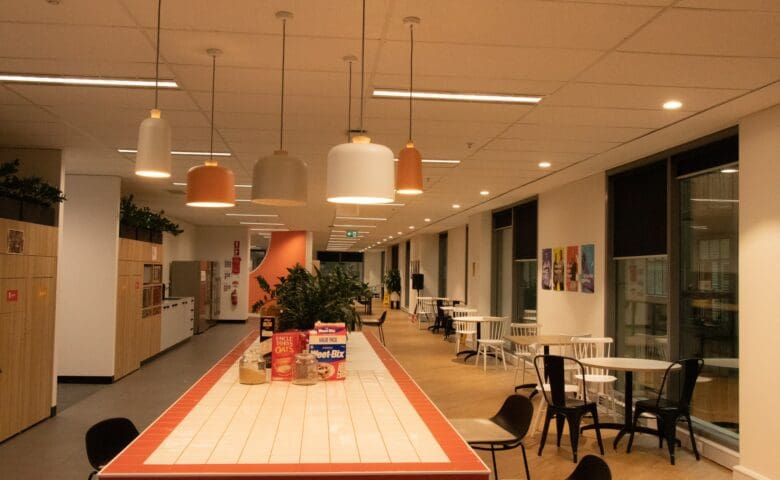Getting Through Winter at the Office
Most staff will be waking up to dark mornings and leaving the office in the dark. It's cold and rainy, so commutes are even more miserable and there's less to do during leisure time outside of the office. Christmas is only a few weeks away and some may be stressed with the cost and organisation associated with it. And to top it all off, it's cold and flu season.
So, what can be done to lift spirits and make sure that staff well-being is cared for over the winter months?
Provide healthy snacks This is important in keeping people alert and productive and stopping the afternoon slump. Comfort eating is common at this time of year and usually there's no shortage of sugary snacks on offer in the lead up to Christmas. Fruit is ideal for getting a sweet hit and vitamins all in one. Iron rich foods are also great for providing energy and keeping people alert. Sugary and caffeinated drinks should be kept to a minimum, so consider stocking up on herbal teas or naturally flavoured water. Encourage movement Holding walking meetings, taking the stairs and getting outside on breaks (if it isn't too cold or wet) are great ways to incorporate movement into the working day. Moving helps to keep you alert and productive, as well as stimulating the release of endorphins to keep spirits up. You could also consider putting together a "deskercise" information sheet with instructions on how to keep active whilst working at a desk. Encourage short breaks Following on from the previous point about keeping active, encouraging staff to take a few minutes break in between tasks is a great way to keep people focused. A few minutes every hour to take the eyes away from a screen and allow the brain to relax a little also helps to keep stress levels down and generally help people to feel less pressured. Consider lighting Keep the blinds open, even when it's cloudy as any natural light is beneficial. Consider investing in lighting that more closely mimics natural daylight. This is important for keeping the body clock on track and keeping us refreshed and productive despite the cold and dark outside. Educate staff on the importance of vitamin D In the winter, there is less sunlight available which means our Vitamin D levels will naturally decrease. This can lead to a more deflated mood and further exaggerate any existing aches and pains. Good quality vitamin D supplements are easily available over the counter and can easily help to restore any depleted levels. Offer help and support Set up exercise or well-being workshops throughout each month or offer access to mental health support - this could be as simple as making staff aware about the type of help that is available and local places they can go to receive support or further information. Consider offering physical health checks to staff to make sure their basic health is looked after. You could also set up awareness classes around smoking and drinking as these habits are generally increased around this time of year and are often popular new year's resolutions which are rarely followed through without the right support and awareness. Also, stress the importance of people going to have their flu jab, and perhaps offer it free of charge to employees. Organise a few fun activities throughout the winter Keep morale high and invest in a few fun days out or evening social gatherings throughout the winter months. Generally people tend to hibernate at this time of year, once the Christmas party season is over. This can affect well-being, their performance at work and team morale. Get staff involved with organising something they would all like to do together, and help them to fund a few activities.How Can I Manage Stress At Work?
On Stress Awareness Day, we look at some ways that stress at work can be managed
Don't stay silent If your workload is too overwhelming, talk to your manager or a colleague. Explain to them why you're struggling, especially if the problem is out of your control. This helps to keep the people around you informed, which in itself should relieve some pressure. A manager or colleague may be able to offer a solution that you hadn't thought of, or even take some of your workload off your shoulders. Take breaks and try to relax Stress slows down and distorts the cognitive functions of the brain. This has a direct impact on productivity and quality of work. While it may seem that you have no time to take breaks, not taking them can actually be counterproductive. Even just a few five minute breaks taken between tasks, or after working for a certain amount of time can help to keep your brain alert. Use this time to look away from your work, (particularly if you use a screen), get up, stretch and move and also make sure you are snacking healthily and keeping hydrated. After an intense or particularly stressful workload is finished, try to take some proper time to recuperate. For example, if a job has taken weeks to complete and has been particularly stressful, consider taking the minimum of a long weekend off. This way, you will have something to look forward too whilst you are doing the work and a great way to wind down before starting a new project. Try to get outside Even if it's a quick, brisk walk around the block during your lunch break, a change of scenery and some fresh air can help to calm you down and refresh your brain. Exercise is a great stress reliever and it also releases endorphins which improve mood. If you can't get outside, try to leave your desk and walk about the building, use the stairs instead of the lift and even consider parking your car further away from the entrance of the building. Try not to take work home with you Don't check your emails after you leave the office, unless it's company policy. When at home, try to spend some time on yourself. A nutritious meal, a soothing bath or shower and a herbal tea or decaffeinated hot drink can all help you to unwind. Try to end screen time from devices and TV at least an hour before you intend to go to sleep. In this time, you could escape into a book, meditate or write your emotions down in a journal. The NHS also has a list of apps that they recommend in order to help with a range of mental health issues, including stress and anxiety.Ergonomic Tips for Teachers
Although teachers are not necessarily sat down for as long as office workers, they are still just as susceptible to musculoskeletal disorders (MSDs)
Standing for extended periods of time, bending or crouching down to low desks and chairs, or sitting on chairs designed for children can all put strain on a teacher's body. MSDs are one of the leading reasons for extended periods of time off across a range of professions throughout the UK workforce. The economical impact of extended absence is huge and in the case of teachers, the academic impact on students also needs to be considered. Research shows that:- 75% of teachers suffer neck and shoulder pain
- 53% have suffered with knee problems
- 33% have had trouble with their hips
- 82% experience MSD related pain at least once a week
What do teachers need to be aware of?
Teachers should pay special attention to how much time they spend on their feet, particularly if they are stood in one place, such as next to the whiteboard, for long periods of time with little movement. Spending a lot of time standing, particularly in one position, can increase the risk of:- Varicose veins
- Poor circulation
- Bunions
- Painful swelling of the feet and legs
- Joint damage
- Lower back pain
- Problems with the feet


